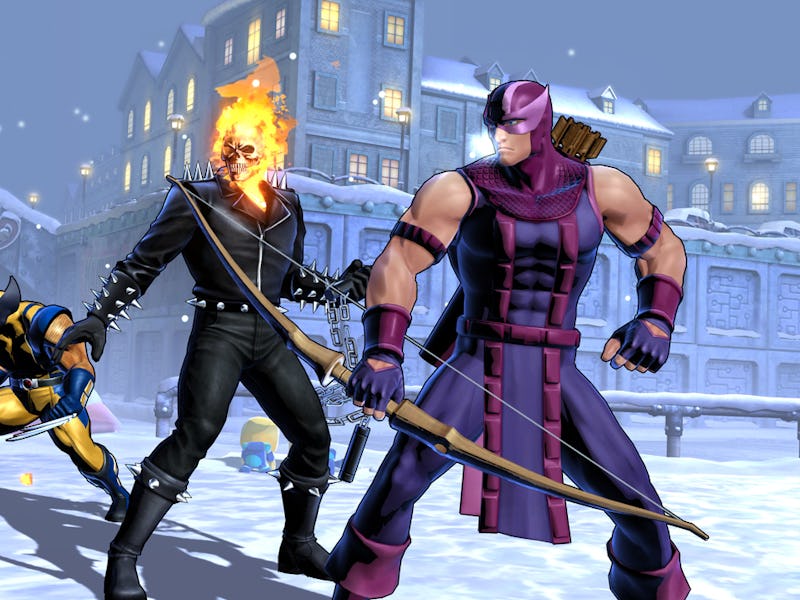There Won't Be a 'Marvel vs. Capcom 4' and That Sucks
A would-be no-brainer is bogged down by boring brand copyrights.

From dominating the global box office to wielding the most recognizable characters in pop culture, you would think it’s a no-brainer for mega-brand Marvel to produce Marvel vs. Capcom 4, a sequel to 2011’s crossover fighting game Marvel vs. Capcom 3, which still lingers in the eSports scene. But Marvel’s position as a powerhouse is precisely why MvC is as dead as Uncle Ben, even when Captain America: Civil War — a movie in which superheroes actually fight each other — makes millions worldwide. Marvel is just too big.
For those unfamiliar: Marvel vs. Capcom was an arcade series that took the most basic, puerile attraction (i.e., superheroes beating each other up) and perfected it. In 2016, Civil War made the gimmick work on the big screen, but in 1994, video games allowed fans to actually engage in the action. In the ‘90s, Marvel neared bankruptcy, so the company licensed its characters to movie and game studios that led to the making of Bryan Singer’s X-Men and Sam Raimi’s Spider-Man. Japanese game publisher Capcom, known for Street Fighter and Resident Evil, began a relationship with Marvel with the ridiculously good X-Men: Children of the Atom. While other game publishers also held the Marvel license, Capcom quickly proved they knew how to use it best.
The game was a success and prompted a sequel, Marvel Super Heroes loosely based on the Infinity Gauntlet storyline that today’s Marvel movies are vaguely modeling after. In 1996, Capcom pitted the X-Men against their own brawlers in X-Men vs. Street Fighter, the first cross-over that showed off what would eventually be the franchise’s key marketing gimmick.
After a few more games, in 2000 Marvel vs. Capcom 2: New Age of Heroes was let loose into arcades, living rooms, bowling alleys, and movie theaters; and it was like God herself made it. The masterpiece was peak MvC: The largest roster ever (56 characters!) including heavy hitters from both sides, all playable via complex mechanics that required a monk’s discipline to master. MvC 2 was also the first in the series to be perfectly translated across platforms — the PlayStation ports of titles before New Age of Heroes were poorly received — so players trained at home before schooling each other at the mall arcades on Friday nights.
For whatever reason, the games didn’t continue for more than a decade. Capcom rose to prominence with its own franchises, like Devil May Cry, Viewtiful Joe (which became huge as a cartoon series), and the reinvention of Resident Evil. Meanwhile, other publishers were given the keys to Marvel, mainly Activision, and a slew of massive hits (and embarrassing misses) were released.
There was the excellent Spider-Man for the PlayStation, and the awful Fantastic Four. There was the great X-Men Legends and The Incredible Hulk: Ultimate Destruction, and the mediocre Marvel Nemesis: Rise of the Imperfects. There was Marvel: Ultimate Alliance which rocked, and there was X-Men Destiny which sucked. In between, there were movie tie-ins that varied from shit (X-Men III: The Last Stand) to the sublime (Spider-Man 2).
But whether they were bad or amazing like Marvel vs. Capcom 2, these games happened at a curious time in Marvel history: when it wasn’t a dominant commercial force. Sure, people knew Spider-Man and they sorta knew Captain America. But these Marvel games were created when Robert Downey Jr. didn’t snark behind designer shades, when no one knew what the heck a Guardian of the Galaxy was, and when Chris Evans was still the Human Torch. When Marvel vs. Capcom 3 arrived in 2011, mostly fueled by nostalgia, it was the right time. Marvel was recognizable but not big (post-Iron Man, pre-The Avengers) while the then-current home consoles were pushed to their technical limits. The next generation of systems would arrive just two years later in 2013.
But, by the release of the Xbox One and PlayStation 4, everything changed. Marvel became Disney in more ways than legal ownership: It became Marvel’s essence. Also, smartphones outpaced consoles by a wider margin — two-thirds of Americans now have one — making apps like Marvel: Contest of Champions more profitable than Marvel vs. Capcom, which really only borrows Marvel, and target a smaller audience. It was for this reason why Marvel (or better yet, Disney) allowed Capcom’s license to expire back in 2014. In fact, Disney has made its own games, with the collectible-driven Disney Infinity that until recently, seemed like a winner.
Marvel is also vengeful over its own characters whose movie rights it doesn’t own. While there’s still new X-Men and Deadpool comics, Marvel is notoriously doing everything it can to bury those characters with the goal to strong-arm ownership back. Wolverine and Deadpool took center stage on the covers of Marvel vs. Capcom 3, but a sequel in today’s Marvel Studios era would feature more Groot and fewer mutants.
Fans seriously want Marvel vs. Capcom 4, but the timing couldn’t be better and worse at once. More people than ever know Marvel and its vast roster of characters, with resurgent interest in the likes of Black Panther to new icons like Miles Morales and Kamala Khan. The content possibilities spanning the Marvel movies and TV shows — Civil War skins! Jessica Jones and Agent Carter as playable characters! Sokovia as an arena! — are promising enough to fulfill its own entire game. But the colossal success of Marvel is exactly why its pursuing its own fate, rather than joining up on someone else’s.
At least the other games still exist. Or would be, if Capcom didn’t pull the games from Xbox and Sony’s digital stores.